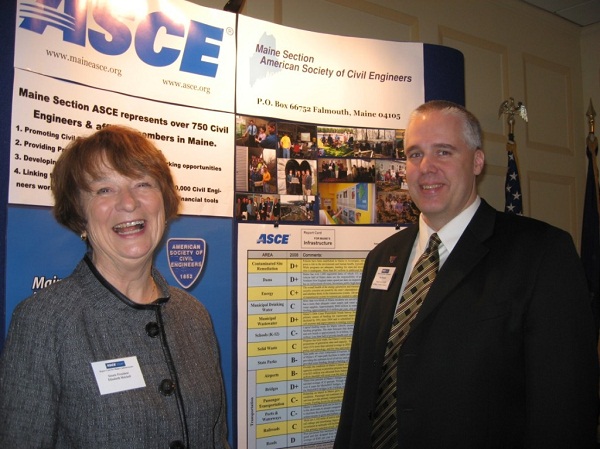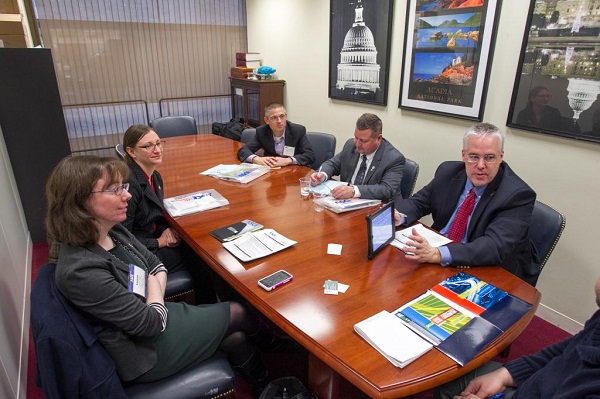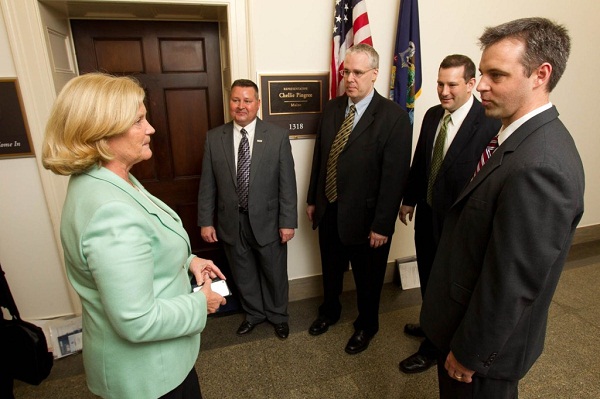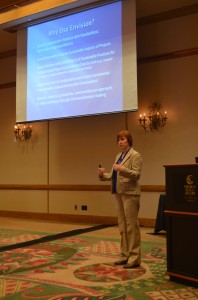Author Archive
Join the #WaterWorks Thunderclap to Show Your Support for Water Infrastructure Investment
September 3rd, 2014 | By: Becky Moylan
Without clean, safe, and reliable water and wastewater systems, one-fifth of our US economy would grind to a halt. Yet, in the 2013 Report Card for America’s Infrastructure, drinking water and wastewater both received D grades.
On Wednesday, Sept. 10, ASCE will join other water leaders as part of the Value of Water Coalition to share the importance of water with White House and Congressional leaders. If you’re not here in DC, you can still show your support and let Congress know that water should be their priority. Consider joining our Thunderclap on social media – you just need to sign up by next Monday. Thunderclap is a tool that lets a message be heard when we all say it together. When you join the #WaterWorks Thunderclap, you and fellow supporters will share the exact same message at the exact same time, spreading an idea across Facebook, Twitter, and Tumblr that cannot be ignored. The goal is to trend in social media. By joining, you’re allowing Thunderclap to share a single message on your behalf. This is only the case when you click the red button on the campaign page to support with Twitter, Facebook, or Tumblr. After the campaign is complete, Thunderclap won’t post any additional messages. Visit here to help the Value of Water Coalition meet its goal and spread the message through Thunderclap on Facebook, Twitter, and Tumblr. The message in the blue box is what will appear on your own social media pages. Just click the red boxes to share the message. It will automatically go out on September 9, 2014 at 12:00pm EST.Tags: Drinking Water, thunderclap, wastewater, water, Water Resources, Water Works
5 Comments »
Advocate Profile: Peter S. Merfeld, P.E., M.ASCE
August 27th, 2014 | By: Becky Moylan
Peter S. Merfeld, P.E., M.ASCE is a member of the Maine Section. He has exhibited leadership experience as section president, Maine Report Card chair, and through work on the national Report Card for America’s Infrastructure. He is also a Board member of IBTTA (International Bridge, Tunnel and Turnpike Association). These roles led him to become an advocate for infrastructure investment on the state and federal levels, an issue that is particularly important currently as the federal Highway Trust Fund heads toward insolvency. As the chief operations officer at the Maine Turnpike Authority, Peter offers day-to-day operational guidance to the Highway & Equipment Maintenance, Engineering & Building Maintenance, and Public Safety departments. He also prepares, plans and oversees the annual Maintenance and Capital Program budget. His role requires him to work closely with the Maine DOT to ensure inter-agency communication and coordination, and review Turnpike policy needs and changes. If you are interested in becoming involved in ASCE’s Key Contact program and promoting the profession through advocacy, you can learn more information and sign up at asce.org. How did you become interested in and get involved in advocacy for your profession? In 2006 as President of the Maine Section, fellow ASCE member and Past-President Phil Dunn gave a report that Michael Michaud, Maine Congressman from the 2nd district had asked Phil “Where is the Maine Report Card?” while he was attending the Fly-In. The Report Card on America’s Infrastructure was seen as a credible tool in providing policy makers with facts about the status of our roads, bridges, and other important infrastructure. After talking with others in Maine section ASCE leadership, it was agreed that having a Maine Report Card could be a great tool for Maine civil engineers to engage our policy makers in a conversation about infrastructure funding. An area that we, as a Section, had not done a great job up to that point. The local Report Card though would be a major undertaking. Due to overwhelming support from the section, I made the easy decision that once I completed my tour as Past-President, in fall 2007 I would take on the role of chair of the committee that would develop and create a Report Card for Maine’s Infrastructure.
Peter Merfeld (right) and Maine Speaker of the House and former Senate President Elizabeth Mitchell at 2008 release of the Report Card for Maine’s Infrastructure

Maine delegation in 2014 with Peter Merfeld presenting the 2013 Report Card for America’s Infrastructure app to Senator Susan Collins (Maine) staff member John Kane.

Congresswoman Chellie Pingree (Maine) speaks with ASCE representatives from Maine in March 2012: Greg Blake, Peter Merfeld, Jason Gallant and Walter Fagerlund.
Tags: advocacy, advocacy profile, Maine
No Comments »
The Highway Trust Fund Deserves More Than a Patch
August 25th, 2014 | By: Becky Moylan
Attention on the Highway Trust Fund seems to have waned since Congress passed a 10-month funding patch in July. However, May will be here before we know it. There is still more work to be done to keep transportation projects across the country funded and our elected leaders need to start having real discussions about long-term sustainable revenue sources now. In the 2013 Infrastructure Report Card, roads received a grade of D, bridges a C+, and transit a D grade. Without long-term investments, America’s transportation systems will continue to limp along with patchwork repairs. ASCE Managing Director of Government Relations, Brian Pallasch, spoke to Bloomberg BNA reporter Heather Caygle as part of the Eye on the Hill series about the state of America’s transportation infrastructure. Watch the interview here to learn more about the importance of infrastructure investment and the need to #FixTheTrustFund.This Week in Infrastructure: Get Noisier!
August 8th, 2014 | By: Becky Moylan
After Congress hit the snooze button on fixing the Highway Trust Fund last week, Transportation Secretary Foxx asked Americans to “get a little noisier” on the issue. You can take Sec. Foxx up on his request at FixtheTrustFund.org. Newspapers across the country featured articles, op-eds, and letters to the editor voicing concerns about Congress’ punt last week and encouraging action for a long-term, sustainable solution. There are plenty of good reasons and sound arguments to share when discussing the value in a fix to the Highway Trust Fund. Instead of short-term gimmicks, there is growing support for an increased gas tax because of the value it would create through investment in roads and bridges. A Highway Trust Fund that has adequate funds ensures that state DOTs can plan projects and leads to modern and innovative infrastructure. Northeastern University researchers shared technology that would help eradicate potholes. Ideas like this one are a great example of where infrastructure is heading, and a healthy Highway Trust Fund makes those innovations all the more likely. Roads and bridges are not the only infrastructure sectors that are crying out for investment either, as evident from the 2013 Report Card for America’s Infrastructure’s D+ GPA across 16 sectors. In the past week, the need for investment in the drinking water and wastewater sectors has been particularly apparent because of the water main break at UCLA in California and the unsafe drinking water in the Toledo, Ohio area. Infrastructure works as an interconnected system, making investment in every sector critical for the others as well. While your elected lawmakers are back home during August recess, take the time to “get noisy” and engage with them about the value in infrastructure investment. When the “noise” is a dialogue armed with economic stats, it can create a compelling argument to #FixtheTrustFund and invest in all sectors of infrastructure.Tags: Drinking Water, gas tax, highway trust fund, water infrastructure
No Comments »
This Week in Infrastructure: Action Packed
August 1st, 2014 | By: Becky Moylan
Between the water main break on UCLA’s campus, the two Senate votes, and House vote to patch the Highway Trust Fund, the high cost of the failure to act was obvious this week. D+ infrastructure, the overall grade in ASCE’s 2013 Report Card for America’s Infrastructure, is in part because of the aging pipes, roads, bridges, and train tracks in the United States. The way to improve the grades is to invest, which would include repairing and replacing infrastructure that has reached the end of its useful life. The Highway Trust Fund is a crucial funding mechanism in raising the grades of roads, bridges and transit. States depend on the federal government to be a partner in funding transportation projects, and unfortunately the long-term status of the Highway Trust Fund is still uncertain. Last week, the House approved a bill that would provide funding to the Highway Trust Fund until May. This week Tuesday, the Senate passed a similar bill, with one crucial difference: the funding would last until December, thus ensuring that Congress would be required to revisit the Highway Trust Fund before the close of the year, and hopefully pass a long-term bill with sustainable funding. Because the two bills were at odds, the House then revisited the legislation on Thursday and voted to remain with the original bill it passed last week. Later that day, the Senate passed the House’s original bill, averting the USDOT’s slowing its payments to states, and the bill will now be sent to the White House for the President’s signature. The bill provides a patch that will sustain the Highway Trust Fund through May. However Congress still has not passed legislation that includes a long-term, sustainable funding solution. Without this, state DOTs will have difficulty moving forward on projects, and Congress will still be focused on averting funding crises, rather than ensuring opportunity for long-term growth through surface transportation projects. Behind every improvement of a Report Card grade and every filled in pothole, there is economic growth and improved commutes. Ultimately that is what this debate is about: improving Americans’ quality of life. While your Congressional members are back home during August recess, take the opportunity to visit or attend a local town hall, and ask your elected lawmakers to #fixtheTrustFund.Tags: congress, Drinking Water, highway trust fund
No Comments »
Advocate Profile: Shelia Montgomery-Mills, P.E., M. ASCE
July 29th, 2014 | By: Becky Moylan
Shelia Montgomery-Mills, P.E., M.ASCE, is a manager of projects and systems at Appleseed Workshop and also owns her own consulting firm, Civil Construction Solutions. She works on commercial and residential renewal projects in Birmingham, Alabama. Shelia’s experiences in her career, along with attending the ASCE Legislative Fly-In, contributed to her active role in advocacy. The Alabama Section is currently working on a state Report Card and starting a Government Relations Committee, both of which Shelia will be involved with. She also serves as the past-president of the Birmingham Branch, vice president of the Alabama Section and is active with supporting the younger members group.Tags: advocacy profile, advocate profile, Alabama, infrastructure
No Comments »
This Week in Infrastructure: All eyes are on the Senate… for next week
July 25th, 2014 | By: Becky Moylan
The Senate will vote early next week on the House’s bill to extend funding to the Highway Trust Fund until May. The upper chamber is poised to debate and vote on the bill and four amendments to it, including the Carper-Corker-Boxer Amendment, which ASCE supports. If passed, the amendment would shorten the funding extension, thus requiring Congress to revisit the topic by December and make a decision to pass a long-term, sustainable bill for the Highway Trust Fund. This would shorten the length of uncertainty for states, and allow for better planning of transportation projects. Maryland’s Senators authored an op-ed on the value in a multi-year transportation bill, again detailing the benefit of longer term transportation funding laws. Vice President Joe Biden tried his hand at the White House White Board video series to explain once again the value in infrastructure investment. While it can often seem Congress is “riding on four flat tires,” as the Pittsburgh Post-Gazette says, there was an encouraging announcement from another part of the federal government, The Department of Agriculture Secretary Tom Vilsack announced $10 billion in private funding for rural infrastructure investment. Next week’s Senate actions will provide clearer next steps in the quest for a long-term, sustainable bill to #FixtheTrustFund.Tags: congress, highway trust fund, infrastructure, White House
No Comments »
This Week in Infrastructure: The House Approves a Highway Trust Fund Patch
July 18th, 2014 | By: Becky Moylan
On Tuesday, the House of Representatives passed a short-term bill to keep the Highway Trust Fund up and running until May 2015. While Democrats were hesitant about the proposal, ultimately the bill passed with bipartisan support, 367-55. In a statement commenting on its passage, ASCE reiterated the need for a long-term, sustainable funding solution. A wide variety of groups urged Congress in a letter to “avoid the immediate transportation cliff and improve the long-term fiscal condition of the Highway Trust Fund.”. The diverse list of co-signers, from the National Retail Federation to the civil rights organization NAACP, and ASCE to Smart Growth America, underscores the potential detriment of inaction. Meanwhile, newspaper editorial boards continue to rally around the idea to increase the gas tax. Most notably this week The New York Times and Bloomberg offered compelling arguments for raising the user fee to ensure it has the buying power of the 2014 dollar. Even comedian Jon Stewart of The Daily Show weighed in with his views on the subject. The White House also focused much of its week on infrastructure investment, releasing a report to support its Rebuild America campaign.Good infrastructure has a ripple effect: Job creation ✓ Less road congestion ✓ More reliable travel times ✓ pic.twitter.com/dhzBo2Whfp
— Vice President Biden (@VP) July 15, 2014
On Thursday, President Obama visited Delaware’s I-495 bridge to announce the administration’s new public-private partnership funding initiative, the Build America Transportation Investment Center. This “one-stop shop” will connect state and local governments with private financing options.
This week the media discussed the Highway Trust Fund frequently, and the topic will likely remain in the headlines into next week as the Senate prepares to act on a program extension. Therefore, there is still much work to be doing to #FixtheTrustFund. Join that effort by contacting Congress now and encouraging long-term, sustainable legislation.
Tags: gas tax, highway trust fund, P3s, surface transportation
No Comments »
ASCE Statement on the Build America Investment Initiative
July 17th, 2014 | By: Becky Moylan
Washington, D.C. — The following is a statement from Randall (Randy) S. Over, P.E., F.ASCE, president, ASCE on the Build America Investment Initiative: “Today’s action by President Obama to launch the Build America Investment Initiative comes at a critical time as we witness Congress still debating how to provide a long-term, sustainable solution to the federal Highway Trust Fund. While private sector financing can by no means replace public funding, states and localities urgently need all of the best tools available to provide transportation solutions for their communities. “The newly-created Build America Transportation Investment Center can play a vital role in sharing best public-private partnerships (P3s) practices and encouraging more states to utilize P3s to a greater degree, thereby creating a more robust U.S. market and attracting private sector investment in our nation’s transportation infrastructure. “ASCE looks forward to working with the Obama Administration to positively implement this action in the coming weeks and months. ASCE supports a comprehensive funding and financing program for operating, maintaining, and improving the nation’s transportation system, which includes P3s, infrastructure banks, bonding and other innovative financing mechanisms. If utilized appropriately, these financing mechanisms can help leverage available transportation funding and play an important role in delivering projects and managing assets effectively.”###
Founded in 1852, the American Society of Civil Engineers represents more than 145,000 civil engineers worldwide and is America’s oldest national engineering society. For more information, visit www.asce.org.Tags: ASCE, bridges, Build America Investment Initative, congress, highway trust fund, infrastructure, P3s, roads, surface transportation, White House
No Comments »
This Week in Infrastructure: House and Senate Plans
July 11th, 2014 | By: Becky Moylan
Congress returned to Washington this week with the Highway Trust Fund on the agenda. The Senate Finance Committee offers a bipartisan proposal by Sen. Ron Wyden of Oregon and Sen. Orrin Hatch of Utah. The House Ways and Means Committee marked up a bill Thursday morning, which is expected to be voted on by the full chamber next week. However, either bill would take some reconciliation to pass through the other chamber. More critically, neither bill provides a long-term, sustainable funding solution. These discussions take place with a backdrop of the DOT warning a 28 percent reimbursement cut for states. “Slower and lower payments,” as Secretary Foxx warned, are concerning states to varying degrees. While some states have contingency plans that will allow projects to continue, the federal government’s role as a partner in transportation is crucial. Vice President Biden echoed this belief on Wednesday, while among government and business officials, including several ASCE members, when he urged Congress to act, both to prevent a shortfall and toward a long-term bill. He noted that historically transportation funding was a bipartisan issue which benefits everyone. Congress is in session for a few more weeks before August recess. Encourage your senators and representative to continue working toward a long-term, sustainable solution to fix the Trust Fund because investing in transportation infrastructure ensures mobility, a benefit to the economy.


 */ ?>
*/ ?>














